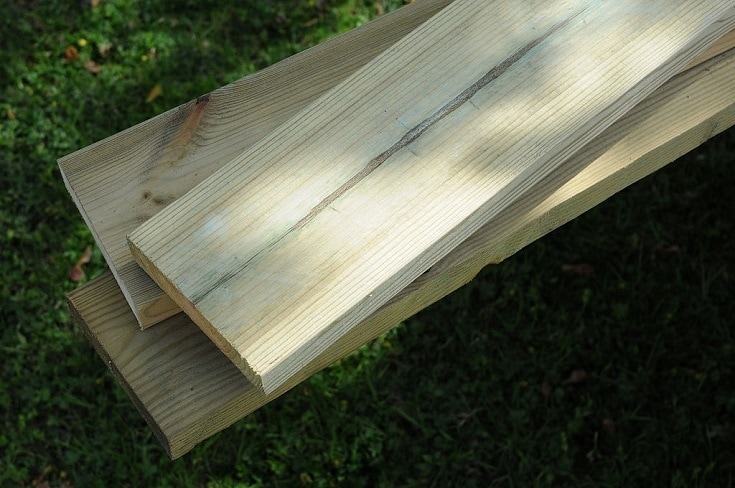Can You Burn Pressure-Treated Wood? Disposal, Facts & FAQs
-
Pete Ortiz
- Last updated:

Putting leftover wood in the fire may be the quickest, easiest, and cheapest way to get rid of it, but if you’re dealing with pressure-treated lumber, you’ll have to find a different disposal method. Pressure-treated wood is full of hazardous preservatives. Burning it releases toxins that can harm people, the environment, and local wildlife, and because of this, the practice is illegal in all 50 states!
 What Is Pressure-Treated Wood?
What Is Pressure-Treated Wood?

Pressure-treated wood is lumber that undergoes a chemical treatment in a vacuum after milling. After the wood goes into the chamber, a high-powered pump extracts the air. A liquid preservative then floods the vessel. As the pressure increases, it forces the chemicals deep into the wood’s cells.
The chemicals in the wood protect it from moisture and pest damage. It resists rot, decay, and insect attacks, allowing it to last in the elements much longer than untreated wood. That makes it ideal for outdoor construction and industrial uses.
- Exposed framing
- Decking and boardwalks
- Fences
- Outdoor furniture
- Railroad ties
- Utility poles
All kinds of hard and softwood varieties can undergo pressure treatment to fortify them against the elements. The type of wood, application, and climate conditions will have a tremendous effect on its lifespan. You may need to replace it after only ten years, but it’s not uncommon for pressure-treated wood to last up to 40 years either.
What Chemicals Are in Pressure-Treated Wood?
Before 2004, most pressure-treated wood was CCA lumber containing chromated copper arsenate. Given the health risks of arsenic, manufacturers worked with the EPA to voluntarily ban the substance for residential use. You can still find CCA wood in commercial settings. Other chemicals in original pressure-treated lumber include creosote and pentachlorophenol (PCP), two heavy-duty pesticides.
Newer pressure-treated wood commonly uses alkaline copper quaternary (ACQ), borates, or copper azole. These have become the standard in many residential and industrial areas because of their lower toxicity levels.
Can You Burn Pressure-Treated Wood?
Burning pressure-treated wood is illegal throughout the United States because of its extreme health and environmental hazards. Smoke and ash from lumber containing arsenic, creosote, and other toxic preservatives can cause disabilities in newborns or long-term health issues, including chronic respiratory diseases and cancer.
Newer products present fewer health issues during handling and use, but setting them on fire still releases copper compounds and other hazardous chemicals into the air and ground. Disposing of these types of pressure-treated wood in a fire is highly dangerous and illegal.
How Do You Get Rid of Pressure-Treated Wood?
Proper handling and disposal are crucial when you have leftover pressure-treated wood. Even if you don’t burn the wood, toxic chemicals can leach into soil and groundwater, impacting the wildlife and possibly your home. Apart from burning it, you should also avoid using it in mulch, compost, food storage containers, or any place that risks the release of those toxins.
Salvaging old pressure-treated wood for other uses is the most convenient way to dispose of it. If you have no use for it, research your local laws for suggestions and locate the nearest landfill. Industrial, commercial, and municipal landfills will often take any pressure-treated lumber off your hands.

How To Tell if Wood Is Pressure-Treated
The easiest way to tell if the wood is pressure treated is to look at the label. New lumber will have a tag stapled to the end identifying what kind of chemicals went into it and a stamp noting the type of wood and its use.
Of course, used wood will likely be missing some or all of these labels, so you may have to rely on the sight and smell tests. Pressure-treated lumber often has a green-olive tint (CCA) or a brown hue (copper), depending on the type of chemical. You may also notice an oily or chemical smell or tiny cuts around the wood where the manufacturer injected the preservatives.
If you’re having trouble identifying the type of wood you have, you may be able to request a fact sheet from the manufacturer as well. With old wood that is impossible to trace or identify, it’s best to play it safe and assume it is pressure treated.
Final Thoughts
Pressure-treated wood has become much safer over the years. With low toxicity options like borate presenting fewer risks, we may soon have pressure-treated lumber that you can recycle in the fire. Until then, it’s crucial to respect the hazards in these materials to protect yourself, your family, and the environment.
Related Read: Can You Stain Pressure Treated Wood? Tips, Tricks, and Best Practices
Featured Image Credit: bricoydeco, Pixabay
Contents

 What Is Pressure-Treated Wood?
What Is Pressure-Treated Wood?